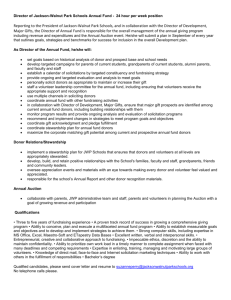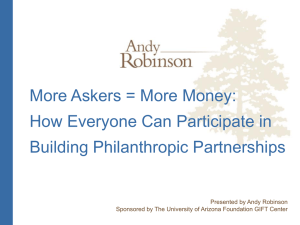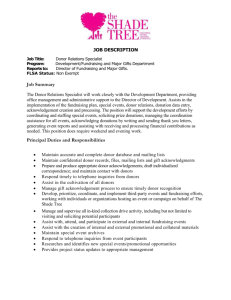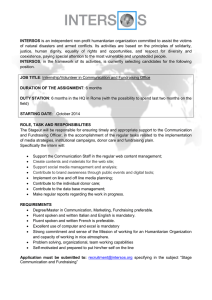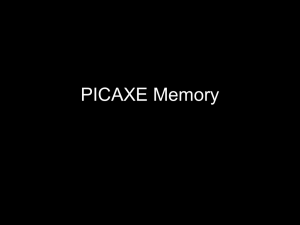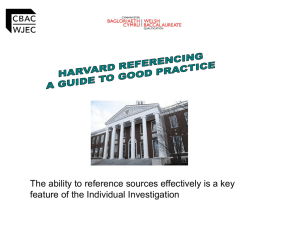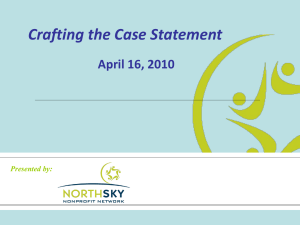Cancer Research UK Marketing Strategy Report
advertisement
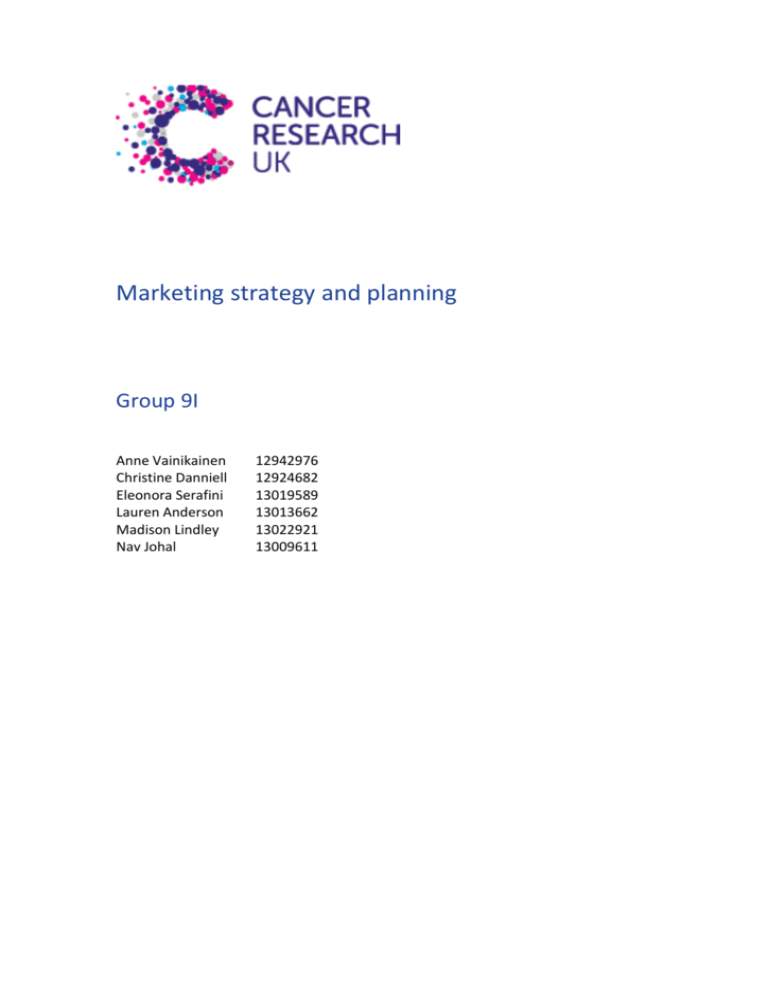
Marketing strategy and planning Group 9I Anne Vainikainen Christine Danniell Eleonora Serafini Lauren Anderson Madison Lindley Nav Johal 12942976 12924682 13019589 13013662 13022921 13009611 Overview Cancer Research UK (CRUK) is the largest cancer research charity in the UK. It funds research into all types of cancer, produces public awareness campaigns and lobbies on key policy issues (Cancer Research UK 2014a:8). This year, CRUK ranked first in the charities category in the annual Consumer Superbrands survey (Superbrands 2014). Its brand is a key asset. In 2013/14, fundraising income rose by 6% to £490 million after an expanded brand campaign (Civil Society 2014). CRUK subsequently raised £8 million from a high-profile fundraising campaign on social media (Cancer Research UK 2014b). CRUK has responded strongly to new ways of fundraising and has particularly benefited from digital expertise, although its competitors are becoming increasingly responsive (The Guardian 2014a). Like most charities, CRUK faces an ageing donor profile and must now consider whether to attract younger donors or tailor fundraising to meet expectations of retired donors (Urbain et al. 2013, Third Sector 2014a). This report adopts the identity salience model of relationship marketing (Knox et al. 2007) to argue that CRUK should adopt a two-pronged strategy, attracting new audiences without alienating existing supporters. It outlines changes in the external environment, particularly the growth of mobile fundraising, which make this feasible. It further contends that CRUK must make use of key assets and capabilities to maintain its position as the largest cancer charity in the UK. It defines key objectives as maintaining brand awareness, more efficient donor recruitment and retention, requiring an investment in data-driven fundraising. Finally, it summarises key learning outcomes and outlines some limitations of the methods adopted. Situation analysis Macro-analysis The Charity Commission’s compliance toolkit (2011) recommends a PESTLE analysis as a means of understanding the impact of factors in the external environment. Political CRUK carries out extensive lobbying in relation to key areas of policy and recently met with over 70 MPs in a ‘record-breaking day of political action’ to launch their general election campaign (Cancer Research UK 2014c). This work is likely to be significantly affected by legislation restricting charitable lobbying, which came into force in September (Third Sector 2014b). Economic CRUK receives no government funding (Cancer Research UK 2014a) and relies on a high volume of donations, with nearly 90% worth £10 or less (Communicate 2012). This makes it particularly vulnerable to fluctuations in living standards (BBC News 2009). Household disposable income remains low, despite the return of GDP to pre-crisis levels (The Guardian 2014b, 2014c), although million-pound donations are rising (Third Sector 2014c). In addition, any decline in the property market directly impacts CRUK’s legacy income stream (Civil Society 2014a), which funds over a third of research (The Telegraph 2014). Social CRUK benefits from the prominence of cancer as a public health issue (Ipsos MORI 2014) and the trend to donate to health-related charities (Saxton and Wang 2014). A rising proportion of donors give spontaneously, particularly first-time donors (Third Sector 2014d) who value the use of social networks and positive messaging over traditional forms of giving (Urbain et al. 2013). CRUK has an ageing donor profile and must consider whether to attract younger donors or tailor fundraising to meet expectations of retired donors (Urbain et al. 2013, Third Sector 2014a). Technological CRUK has responded strongly to mobile giving, which now accounts for £26 in every £100 donated in the UK (Wired 2013) and will become even more significant with further smartphone adoption (Google 2014). CRUK faces key challenges in engaging new audiences outside its traditional donor profile (Saxton and Wang 2014, Facebook and Instagram for Social Good 2014) and adapting to emerging trends (The Guardian 2014b, 2014d). Big data is particularly significant, presenting a key opportunity for highly targeted solicitations and real-time evidencing of impact (The Wall Street Journal 2013). Legal CRUK’s current privacy policy (2014d) would be dramatically affected by EU data protection proposals, which represent ‘the biggest challenge in fundraising for a generation’ by seeking to restrict the use of data for donor profiling (Civil Society 2014b). CRUK’s legacy income is likely to benefit from changes to inheritance tax law (The Telegraph 2011), whilst its policy work could be impacted by a review of lobbying legislation next year (NCVO 2014). Ethical CRUK’s use of unpaid internships has been criticised by the social mobility watchdog (Third Sector 2013, The Independent 2014), whilst the salary of its CEO has received parliamentary criticism (The Guardian 2013a). It is also starting to be more open about animal testing (The Guardian 2014e). Micro-analysis Arnett et al. argue that successful non-profit marketing ‘generates supportive behaviour from key stakeholders’ including donations and positive word of mouth (2003:92). As a major medical research charity, CRUK’s external stakeholders (Figure 1) mirror those studied by Knox et al. (2007:119). Figure 1. Key external stakeholders across the value chain The identity salience model of relationship marketing suggests that long-term relationships are best developed by activities that increase stakeholder involvement and attachment (Arnett et al. 2003:100). Recently, stakeholders have come to expect targeted information to demonstrate impact (Carim and Warwick 2013:524). As such, structured communications based on stakeholder segmentation increase engagement and, ultimately, donations (Srnka et al. 2003, Waters 2011). Knox et al. adapted Mitchell’s theory of stakeholder saliency for a medical research charity. They found stakeholder saliency to be socially constructed by management, with three perspectives (Figure 2) affecting the perceived importance of stakeholder audiences (2007:122-126). These distinct worldviews prioritise grant recipients, donors and the general public respectively. The direction of marketing strategy is thus ‘contingent upon which worldview garners the most management attention’ (Knox et al. 2007:126). Figure 2. Three perspectives affecting stakeholder saliency A 2012 rebrand aimed to position CRUK as an organisation that saves lives in the community, ‘rather than a science organisation’ (Communicate 2012). CRUK described its purpose as ‘increasing income to fund research’ (Civil Society 2012). This suggests that CRUK consciously attempted to move away from the first worldview towards greater prioritisation of donors and the general public. This strategic positioning is likely to further strengthen CRUK’s brand, enhancing its competitive advantage over smaller charities (Chew 2009:223). CRUK’s key competitors can be established by examining the Third Sector Charity Brand Index (2014e) and YouGov’s Charity Index (2014), which measure public perception of charity brands. They show that Macmillan Cancer Support is CRUK’s main competitor, although Marie Curie Cancer Care also performs strongly. CRUK’s income far exceeds both charities – it raised £490 million in 2013/14 (Cancer Research UK 2014e) compared to £186.9 million and £136 million (Macmillan 2014, Marie Curie 2014). It also faces competition from other large health charities such as the British Heart Foundation (Hibbert 1996). CRUK’s assets and capabilities provide the basis for a positioning strategy of differentiation (Hooley 2012:133). Reputation and stakeholder relationships are important intangible assets for charities (Chew 2009:42). CRUK’s size provides an inherent advantage, with extensive PR reinforcing its reputation as an authoritative voice on research (Hibbert 1995:24). CRUK’s relationship with Tesco is also significant as a means of increasing brand awareness by mass exposure through its 300,000 stores (The Guardian 2013b). The in-depth partnership is immensely successful at fundraising, producing £11.85 million in 2012 (Tesco 2013). This dwarfs the amount raised by similar partnerships, with Marks & Spencer raising £1.2 million for Macmillan in 2013 (Macmillan 2014b). However, maintaining this relationship requires immense resources, including seven fundraising account managers (The Guardian 2013b). Its strategic fit must be considered ‘in terms of mission, target audience, and/or values’ (Becker-Olsen and Hill 2006:75). Whilst target audiences are aligned in terms of broad reach, Tesco’s mission and values are not health-related (Tesco 2014) and its brand has plummeted in recent weeks (Marketing Week 2014a). In this regard, Macmillan’s partnership with Boots (2014) is arguably more suitable. Key capabilities facilitate effective deployment of assets and create competitive advantage (Chew 2009:42). They include CRUK’s agile approach to marketing and digital expertise, which resulted in £8 million raised by the #nomakeupselfie campaign (Marketing Week 2014b, Cancer Research UK 2014b). CRUK’s competitors have struggled to become more responsive (The Guardian 2014b), although Macmillan’s brand metrics rose significantly after hijacking #icebucketchallenge (Marketing Week 2014c). In contrast, CRUK’s comparative weaknesses include the difficulty of establishing an emotional connection to research and evidencing impact of donations (Facebook and Instagram for Social Good 2014). CRUK has also experienced problems with staff retention after high-profile campaigning (Marketing Week 2014a). The above analysis can be summarised in a SWOT analysis to enable strategy formulation (Hooley 2012:38). Strengths Strong brand Corporate partnerships Digital expertise Political networking Opportunities Mobile fundraising Big data Legacy giving Weaknesses Vulnerable to economic changes Evidencing impact Intangible concept of research Competing worldviews Staff retention Threats Data protection legislation More responsive competitors Ageing donor profile Public perception of CEO’s salary and unpaid internships Marketing strategy Strategic implications for resource deployment can be revealed by examining links between strengths and weaknesses, opportunities and threats (Hooley 2012:39). Opportunities Strengths Invest in new fundraising opportunities, including mobile giving Use big data to better target solicitations Leverage social networks of corporate partnerships in mobile fundraising Threats Weaknesses Use big data to evidence impact of donations Invest in core income activities like legacy marketing to reach older donors Use digital expertise to counter ageing donor profile by attracting younger audiences Brand campaigns to maintain engagement amongst existing supporters Use digital expertise to attract new supporters and monitor trends Benchmarking against key stakeholder relationships of competitors Use political networks to lobby against EU data protection proposals Regular benchmarking of staff compensation and benefits against key competitors Make research tangible by focusing on human stories Seek new corporate partners more in line with CRUK’s mission and values With the rebrand, CRUK has started to reposition itself as an organisation that saves lives, focusing on human stories in order to establish an emotional connection to research (Communicate 2012). This repositioning links to the three management worldviews identified above (Figure 2) from which three strategic choices arise (Knox et al. 2007:126). As Chew argues, stakeholder dependence is as critical for charities as marketorientation and resource-based perspectives (2009:204). It is therefore necessary to consider stakeholder saliency alongside changes in the external environment and the need to exploit internal resources and capabilities. Option 1: Prioritise grant recipients with a focus on core income activities Over a third of CRUK’s research is funded by legacy donations (The Telegraph 2014), so this approach emphasises more traditional fundraising activities, with a focus on older donors. This approach aims to achieve differentiation through fortification defence, utilising CRUK’s brand and improving key activities known to generate core income in order to ‘shut out competitor attacks’ (Hooley 2012:283). Option 2: Prioritise donors with investment in new fundraising opportunities This approach responds to changing donor behaviour, including the growth of mobile fundraising and the rise of spontaneous and first-time donors. It focuses on a younger audience, with particular emphasis on social media and text giving. It aims to achieve mobile defence by adapting to emerging trends (Hooley 2012:285). Option 3: Prioritise the general public with a focus on community engagement CRUK considers its focus on research to be less engaging than the palliative care provided by its competitors (Facebook and Instagram for Social Good 2014), so this approach counters utilises human stories to demonstrate the impact of research in the community. It adopts a two-pronged strategy towards younger and older audiences, utilising targeted messaging, big data and digital expertise. This focus on closer stakeholder relationships can be considered a frontal attack on competing charities (Hooley 2012:280). Whilst the prioritisation of grant recipients would seem a logical choice for a cancer research charity, CRUK perceives the prioritisation of grant recipients as limiting its potential to reach other audiences. Instead, its rebrand aimed to ‘unite the two human and scientific sides of the business’ with messaging focused on donor empowerment (Rebrand 2014). The rebrand can be situated as part of a strategy to engage new supporters and develop stronger relationships with current supporters by creating a brand more appealing for younger, digital audiences (Civil Society 2012). Consequently, it would appear that the second approach is better aligned with CRUK’s overall business strategy than the first. The prioritisation of changing donor behaviours is arguably more responsive to changes in the external environment, most notably the adoption of mobile fundraising by key competitors. However, there remains a need to retain engagement of older donors, who typically give larger amounts and contribute significantly through legacy donations. The third approach perceives the key challenge for CRUK as how to attract new audiences without alienating existing supporters. This is closely aligned with its ‘digital by default’ business strategy, which seeks to be audience led (The Guardian 2014). Investment in big data and digital expertise will provide sophisticated means of targeting older and younger donors (The Wall Street Journal 2013). Research shows that that a focus on engagement as an antecedent of donor retention is likely to make CRUK more efficient and effective (Arnett et al. 2003, Knox et al. 2007, Sargeant 2008, Carim and Warwick 2013). As such, it forms a compelling basis for establishing long-term strategic advantage. Objectives and targets Sustain greater brand awareness than any other cancer charity Achieve 5% more annual media coverage than key competitors Engage 20% more during digital campaigns than closest competitor Maintain top three ranking in YouGov and Third Sector charity brand indexes over five years Attract new donors from a wider audience Increase share of donations to cancer charities by 15% over five years Improve ratio of donor recruitment from campaigns by 2% every year Maintain engagement with 50% of spontaneous donors for six months Complete marketing research into donor expectations by 2015 Review best practices in data-driven fundraising by 2016 Improve relationships with existing donors Increase retention of first-time donors by 10% over five years Reduce attrition rate from sustainable giving by 5% over five years Convert 7% of existing donors to legacy donors within five years Review welcome cycles for mobile donors by mid-2015 Donor retention is two to three times less expensive than recruitment and is enhanced by frequent, two-way communications with donors (Sargeant 2008:10). Performance will be benchmarked against key competitors using sentiment tracking, digital analytics, annual charity brand indexes and public accounts. Conclusions Changes in the external environment have created new and more sophisticated ways of fundraising. If CRUK is to maintain its position as the largest cancer charity in the UK, it must attract new audiences and seek greater engagement with existing supporters. This will require sustained brand awareness and investment in donor targeting, particularly donor retention. A key limitation of this strategy is the lack of access to management, which means that the analysis of stakeholder saliency is based on news articles and previous research (Knox et al. 2007, Marketing Week 2013, The Guardian 2014f). A further limitation is the lack of access to internal data, which means that targets are based on publicly available data. As such, targets have been formulated ‘to match or exceed the market-growth rate and thereby hold or extend market share’ (McDonald 2007:325). Where possible, figures are based on the average rates of attrition and legacy donation for UK charities (Sargeant 2008, Nonprofit Quarterly 2013, The Guardian 2014g). Further research would benefit from in-depth interviews with key stakeholders to determine the applicability of the identity salience model, as well as a thorough evaluation of organisational culture and day-to-day working practices. References Arnett et al. 2003. Identity salience model of relationship marketing success. Journal of Marketing, 67:89-105. BBC News. 2009. Charity donation hit by recession, accessed 21st October 2014 from http://news.bbc.co.uk/1/hi/uk/7946518.stm Boots. 2014. Partnership with Macmillan Cancer Support, accessed 19th October 2014 from http://www.bootsuk.com/corporate_social_responsibility/community/partnership-withmacmillan.aspx Cancer Research UK. 2014a. Beating cancer sooner, accessed 14th October 2014 from http://www.cancerresearchuk.org/sites/default/files/cruk_strategy.pdf Cancer Research UK. 2014b. #nomakeupselfie trend raises over £8 million for Cancer Research UK, accessed 11th October 2014 from http://www.cancerresearchuk.org/about-us/cancer-news/press-release/2014-0325-nomakeupselfie-trend-raises-over-ps8-million-for-cancer-research-uk Cancer Research UK. 2014c. Campaign news, accessed 4th November 2014 from http://www.cancerresearchuk.org/support-us/campaign-for-us/campaign-news Cancer Research UK. 2014d. Privacy statement, accessed 2nd November 2014 from http://www.cancerresearchuk.org/terms-and-conditions/privacy-statement Cancer Research UK. 2014e. Annual review 2013/14, accessed 28th October 2014 from http://www.cancerresearchuk.org/sites/default/files/cruk_annual_review_2013_ 14.pdf Carim, L. and Warwick, C. 2013. Use of social media for corporate communications by research-funding organisations in the UK. Public Relations Review, 39(5):521525. Chew, C. 2009. Exploring strategic positioning in the UK charitable sector: emerging evidence from charitable organisations that provide public services. British Journal of Management, 20:90-105. Civil Society. 2012. CRUK in £680,000 brand refresh, accessed 20th October 2014 from http://www.civilsociety.co.uk/fundraising/news/content/13136/cruk_in_07m_br and_refresh Civil Society. 2014a. Cancer Research UK income rises 10 per cent in a year, accessed 5th November 2014 from http://www.civilsociety.co.uk/finance/news/content/17942/cancer_research_uk _income_rises_10_per_cent_in_a_year Civil Society. 2014b. EU data protection proposals would kill fundraisers’ mailing lists, says report, accessed 5th November 2014 from http://www.civilsociety.co.uk/fundraising/news/content/18058/eu_data_protecti on_proposals_would_make_fundraisers_mailing_lists_disappear_says_report Communicate. 2012. Brand:Rebrand - Cancer Research UK, accessed 28th October 2014 from http://www.communicatemagazine.co.uk/archive/157-nov-dec2012/4204-brandrebrand-cancer-research-uk Facebook and Instagram for Social Good. 2014. Interview with Cancer Research UK social media team during conference held at Millbank Tower, London SW1P 4QP on 2nd October 2014 Google. 2014. Any place, any time, any device: building websites for the multi-screen consumer, accessed 20th October 2014 from http://static.googleusercontent.com/media/www.google.com/en//intl/ALL_uk/th ink/multiscreen/pdf/multi-screen-consumer-whitepaper_research-studies.pdf Hibbert, S. 1996. Giving to charity: questioning the donor decision process. The Journal of Consumer Marketing, 13(2):4-13. Hooley, G. 2012. Marketing Strategy and Competitive Positioning. Financial Times/Prentice Hall: London, UK. Ipsos MORI. 2014. 2014 public awareness and opinion survey, accessed 28th October 2014 from https://www.ipsosmori.com/Assets/Docs/Publications/SRI_Health_2014_public_awareness_and_op inion_survey.pdf Knox et al. 2007. The application of stakeholder theory to relationship marketing strategy development in a non-profit organisation. Journal of Business Ethics, 75:115-135. Macmillan. 2014a. Annual reports and accounts, accessed 20th October 2014 from http://www.macmillan.org.uk/Aboutus/HowWeRaiseAndSpendOurMoney/Annua l_reports_and_reviews.aspx Macmillan. 2014b. Marks & Spencer, accessed 1st November 2014 from http://www.macmillan.org.uk/Aboutus/OurCorporatePartners/MarksSpencer.asp x Marie Curie. 2014. Reports and accounts, accessed 29th October 2014 from http://www.mariecurie.org.uk/en-gb/who-we-are/reports-and-accounts/?Tab=2 Marketing Week. 2014a. Tesco’s corporate woes torpedo brand perception, accessed 29th October 2014 from http://www.marketingweek.com/2014/09/24/tescoscorporate-woes-torpedo-brand-perception/ Marketing Week. 2013. Cancer Research UK fights to ‘beat cancer sooner’ in marketing campaign, accessed 20th October 2014 from http://www.marketingweek.com/2013/12/20/cancer-research-uk-fights-to-beatcancer-sooner-in-marketing-campaign/ Marketing Week. 2014b. Can your team pass the agility test like Cancer Research?, accessed 29th October 2014 from http://www.marketingweek.co.uk/disciplines/social-media/opinion/can-yourteam-pass-the-agility-test-like-cancer-research/4010454.article Marketing Week 2014c. Macmillan defends itself against criticism it hijacked the Ice Bucket Challenge, accessed 20th October 2014 from http://www.marketingweek.com/2014/08/26/macmillan-defends-itself-againstcriticism-it-hijacked-the-ice-bucket-challenge NCVO. 2014. Government to amend lobbying bill following pressure from charities, accessed 1st November 2014 from http://www.ncvo.org.uk/about-us/mediacentre/press-releases/524-government-amend-lobbying-bill-pressure-charities Rebrand. 2014. Cancer Research UK, accessed 18th October 2014 from http://rebrand.com/best-cancer-research-uk Saxton, G. and Wang, L. 2014. The Social Network Effect: The Determinants of Giving Through Social Media. Nonprofit and Voluntary Sector Quarterly, 43(5):850–868. Srnka et al. 2003. Increasing fundraising efficiency by segmenting donors. Australasian Marketing Journal, 11.1:70-86. Superbrands. 2014. Consumer Superbrands 2014, accessed 14th October 2014 from http://d3iixjhp5u37hr.cloudfront.net/files/2014/06/CSB-2014-Official-ResultsMvFjW2.pdf Tesco. 2014. Core purpose and values, accessed 18th October 2014 from http://www.tescoplc.com/index.asp?pageid=10 The Charity Commission. 2011. Charities: due diligence checks and monitoring end use of funds, accessed 3rd November 2014 from https://www.gov.uk/government/publications/charities-due-diligence-checksand-monitoring-end-use-of-funds The Guardian. 2013a. The charity sector has problems, but executive pay is hardly the worst, accessed 19th October 2014 from http://www.theguardian.com/commentisfree/2013/dec/19/problems-charitysector-executive-pay-bosses The Guardian. 2013b. How to become a company’s charity of the year, accessed 29th October 2014 from http://www.theguardian.com/voluntary-sectornetwork/2013/jan/29/become-companys-favourite-charity The Guardian. 2014a. #wakeupcall:has the face of fundraising changed for good?, accessed 14th October 2014 from http://www.theguardian.com/voluntarysector-network/2014/oct/14/wakeupcall-selfie-fundraising-evolution The Guardian. 2014b. UK economy bigger and growing faster than thought, says ONS, accessed 2nd November 2014 from http://www.theguardian.com/business/2014/sep/30/uk-economy-bigger-fasterons The Guardian. 2014c. Fall in UK living standards deeper than thought, TUC says, accessed 2nd November 2014 from http://www.theguardian.com/business/2014/sep/30/fall-uk-living-standardsdeeper-ons-tuc The Guardian. 2014d. #nomakeupselfie - why it worked, accessed 7th October 2014 from http://www.theguardian.com/voluntary-sectornetwork/2014/mar/25/nomakeupselfie-viral-campaign-cancer-research The Guardian. 2014e. Companies, universities and charities vow to reveal more on animal testing, accessed 22nd October 2014 from http://www.theguardian.com/world/2014/may/14/companies-vow-to-be-moretransparent-on-animal-testing The Guardian. 2014f. ‘Cancer Research UK’s digital strategy is not just about technology, it’s about people’, accessed 18th October 2014 from http://www.theguardian.com/voluntary-sector-network/iof-partnerzone/2014/sep/09/digital-technology-fundraising-cancer-research The Guardian. 2014g. Fundraisers need to be brave to change the face of legacy giving, accessed 5th November 2014 from http://www.theguardian.com/voluntary-sector-network/iof-partnerzone/2014/nov/04/legacy-giving-fundraisers-must-be-brave?CMP=new_1194 The Independent. 2014. Ban unpaid internships completely, says Social Mobility Commission, accessed 1st November 2014 from http://www.independent.co.uk/news/uk/politics/ban-unpaid-internshipscompletely-says-social-mobility-commission-9796805.html Nonprofit Quarterly. 2013. Donor retention: what do we know and what can we do about it?, accessed 4th November 2014 from https://nonprofitquarterly.org/philanthropy/22708-donor-retention-what-do-weknow-what-can-we-do-about-it.html Sargeant, A. 2008. Donor retention: what do we know and what can we do about it?, accessed 2nd November 2014 from http://www.afpnet.org/files/ContentDocuments/Donor_Retention_What_Do_W e_Know.pdf The Telegraph. 2011. Change inheritance tax laws encourages charitable giving, accessed 2nd November 2014 from http://www.telegraph.co.uk/finance/personalfinance/how-budget-affectme/8402261/Change-in-Inheritance-Tax-laws-encourages-charitable-giving.html The Telegraph. 2014. Will you leave a life-saving legacy?, accessed 20th October 2014 from http://www.telegraph.co.uk/sponsored/health/beatcancer/11032415/leave-money-to-charity-in-your-will.html The Wall Street Journal. 2013. How big data will change the face of philanthropy, accessed 20th October 2014 from http://www.theguardian.com/voluntary-sectornetwork/2013/jan/07/top-charities-innovative-fundraising Third Sector. 2013. Analysis: The rise and rise of the unpaid charity intern, accessed 2nd November 2014 from http://www.thirdsector.co.uk/analysis-rise-rise-unpaidcharity-intern/management/article/1207509 Third Sector. 2014a. Charities should build relationships with a new generation of rich retired people, study says, accessed 4th October 2014 from http://www.thirdsector.co.uk/charities-build-relationships-new-generation-richretired-people-study-says/fundraising/article/1320233 Third Sector. 2014b. Lobbying act regulated period for 2015 general election begins, accessed 28th October 2014 from http://www.thirdsector.co.uk/lobbying-actregulated-period-2015-general-election-begins/policy-andpolitics/article/1312963 Third Sector. 2014c. Number of million-pound donations in UK is at highest level since 2008, accessed 4th November 2014 from http://www.thirdsector.co.uk/number-million-pound-donations-uk-highest-level2008/fundraising/article/1320211 Third Sector. 2014d. Charity Brand Index launch reveals rising proportion of donors who give only spontaneously, accessed 5th November 2014 from http://www.thirdsector.co.uk/charity-brand-index-launch-reveals-risingproportion-donors-give-spontaneously/fundraising/article/1319897 Third Sector. 2014e. Cancer Research UK named best charity brand of 2014, accessed 28th October 2014 from http://www.thirdsector.co.uk/cancer-research-uknamed-best-charity-brand-2014/communications/article/1309460 Urbain et al. 2013. What does the future hold for giving? An approach using the social representations of Generation Y. International Journal of Nonprofit and Voluntary Sector Marketing, 18:152-171. Waters, R. 2011. Tweet, tweet, tweet: A content analysis of nonprofit organizations’ Twitter updates. Public Relations Review, 37:321-324. Wired. 2013. Quarter of charity funds now raised through online and mobile, accessed 20th October 2014 from http://www.wired.co.uk/news/archive/201311/27/charity-and-social-media YouGov. 2014. Macmillan Cancer Support tops YouGov’s mid-year charity rankings, accessed 18th October 2014 from http://yougov.co.uk/news/2014/07/16/macmillan-cancer-support-tops-yougovsmid-year-cha/
